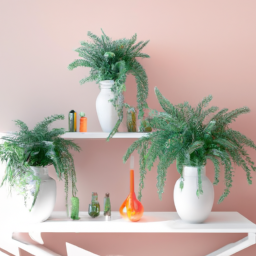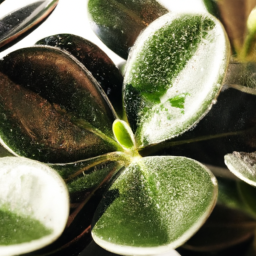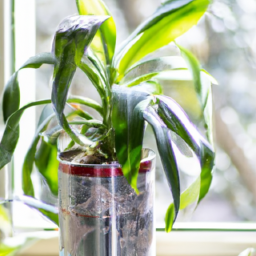
Have you ever noticed mold growing near your indoor plants and wondered, “Can indoor plants cause mold?” It’s a common question among plant enthusiasts and homeowners alike. While indoor plants offer numerous benefits, they can also create the perfect environment for mold to thrive. In this blog post, we’ll explore the relationship between indoor plants and mold, and provide tips on how to prevent and manage mold growth in your home.
Can Indoor Plants Cause Mold
Understanding the Relationship Between Indoor Plants and Mold
Indoor Plants and Mold Growth
Indoor plants can indeed contribute to mold growth if not properly cared for. Mold thrives in damp and humid environments, and indoor plants can create the perfect conditions for mold to develop. When plants are overwatered or placed in areas with poor air circulation, excess moisture can accumulate in the soil and on the leaves, providing a breeding ground for mold spores.
To prevent mold growth on indoor plants, it is essential to maintain proper watering practices and ensure adequate ventilation in the room where the plants are located. By taking these precautions, you can enjoy the benefits of indoor plants without the risk of mold contamination.
It is also important to note that certain types of plants are more prone to mold growth than others. Plants with thick foliage or hairy leaves are more likely to trap moisture and create a favorable environment for mold. If you notice mold starting to develop on your indoor plants, it is crucial to take immediate action to prevent it from spreading.
Signs of Mold on Indoor Plants
There are several telltale signs that mold may be growing on your indoor plants. These include a musty or earthy odor coming from the plant, discolored or fuzzy patches on the leaves or soil, and a decline in the plant’s overall health. If you notice any of these symptoms, it is essential to act quickly to address the mold infestation before it spreads to other plants or surfaces in your home.
In some cases, mold growth on indoor plants can also lead to health issues for individuals who are sensitive to mold spores. Symptoms may include respiratory problems, skin irritation, and allergic reactions. To protect your health and the health of your plants, it is crucial to take proactive measures to prevent mold growth in your indoor garden.
By staying vigilant and monitoring your plants regularly, you can catch mold growth early and take steps to eliminate it before it becomes a more significant issue. With proper care and attention, you can enjoy the beauty and benefits of indoor plants without the risk of mold contamination.
Preventing Mold on Indoor Plants
Proper Watering Techniques
One of the most common causes of mold growth on indoor plants is overwatering. To prevent mold from developing, it is essential to water your plants only when the soil is dry to the touch. Avoid letting water accumulate in the saucer or tray beneath the plant, as this can create a humid environment that is conducive to mold growth.
When watering your plants, be sure to use room-temperature water and water the soil directly, avoiding getting water on the leaves. This will help prevent excess moisture from accumulating on the plant’s foliage and reduce the risk of mold infestation.
Additionally, it is crucial to use well-draining soil and pots with drainage holes to allow excess water to escape. Proper drainage will help prevent waterlogged soil and reduce the likelihood of mold growth on your indoor plants.
Optimizing Air Circulation
Another key factor in preventing mold growth on indoor plants is ensuring adequate air circulation in the room where the plants are located. Stagnant air can trap moisture around the plants, creating an ideal environment for mold to thrive. To improve air circulation, consider using a fan or opening windows periodically to allow fresh air to flow through the space.
You can also group plants together to create a microclimate that promotes air movement and helps prevent moisture buildup. By strategically placing your plants and optimizing airflow in your home, you can reduce the risk of mold growth and keep your indoor garden healthy and vibrant.
In addition to enhancing air circulation, it is essential to maintain a consistent temperature and humidity level in the room where your plants are located. Mold thrives in high humidity environments, so keeping the humidity level below 60% can help prevent mold growth on your indoor plants.
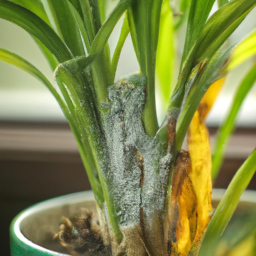
Signs and Symptoms of Mold on Indoor Plants
Identifying Mold on Indoor Plants
When it comes to indoor plants, mold can be a common issue that many plant owners face. Mold is a type of fungus that thrives in damp and humid conditions, making indoor plants an ideal environment for its growth. There are several signs and symptoms that can indicate the presence of mold on your indoor plants.
One of the most obvious signs of mold on indoor plants is the appearance of fuzzy, white, black, or green spots on the leaves, stems, or soil of the plant. These spots can vary in size and may appear powdery or slimy in texture. Additionally, mold can also cause a musty or earthy smell to emanate from the plant, indicating its presence.
Another common symptom of mold on indoor plants is the development of yellowing or browning of the leaves. Mold can disrupt the plant’s ability to absorb nutrients and water, leading to a decline in overall health and appearance. In severe cases, mold infestations can cause the plant to wilt, droop, or even die.
In some cases, mold on indoor plants can also lead to the formation of fuzzy growths on the roots of the plant. This can be particularly concerning as it can impact the plant’s ability to take up water and nutrients from the soil, further exacerbating its decline. If left untreated, mold on the roots can eventually lead to root rot and the eventual death of the plant.
Preventing Mold on Indoor Plants
Preventing mold on indoor plants starts with creating the right growing conditions for your plants. Proper ventilation, adequate air circulation, and appropriate watering practices can all help reduce the risk of mold growth on your indoor plants. Here are some tips to help prevent mold on your indoor plants:
1. Allow the soil to dry out between waterings to prevent excess moisture buildup, which can create an ideal environment for mold to thrive.
2. Avoid overwatering your plants, as this can lead to waterlogged soil and increased humidity levels, promoting mold growth.
3. Ensure proper drainage by using pots with drainage holes and removing excess water from saucers or trays to prevent water from pooling around the roots.
4. Monitor humidity levels in your home and use a dehumidifier if necessary to maintain a healthy environment for your plants.
5. Inspect your plants regularly for any signs of mold or fungal growth and take prompt action to address the issue before it spreads.
By following these tips and staying vigilant for any signs of mold on your indoor plants, you can help ensure that your plants remain healthy and free from mold infestations.
Treating Mold on Indoor Plants
If you do discover mold on your indoor plants, it’s important to take immediate action to prevent the spread of the fungus and save your plant. Here are some steps you can take to treat mold on indoor plants:
1. Remove any visibly affected plant parts, such as leaves or stems, using clean, sharp scissors or pruning shears. Be sure to disinfect your tools between cuts to prevent the spread of mold spores.
2. Gently wipe down the remaining parts of the plant with a damp cloth or sponge to remove any remaining mold spores. Avoid using harsh chemicals or cleaners, as these can damage the plant.
3. Repot the plant in fresh, sterile soil to prevent the reoccurrence of mold. Be sure to clean and disinfect the pot before replanting to remove any lingering mold spores.
4. Adjust your watering and humidity levels to create a less favorable environment for mold growth. Consider moving the plant to a location with better air circulation and light exposure.
5. Monitor the plant closely for any signs of regrowth or worsening symptoms, and continue to take preventive measures to keep mold at bay.
By taking these steps and being proactive in addressing mold on your indoor plants, you can help protect your plants from further damage and ensure their continued health and vitality. Remember, prevention is key when it comes to mold on indoor plants, so be sure to maintain good growing conditions and keep a close eye on your plants for any signs of trouble.
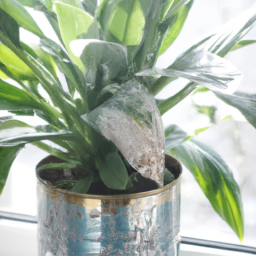
Can Indoor Plants Cause Mold
As an expert in indoor plant care, I have encountered many cases where indoor plants have caused mold growth in homes. While indoor plants can bring beauty and freshness to your living space, they can also create the perfect environment for mold to thrive if not properly cared for. In this article, we will explore the relationship between indoor plants and mold, and provide you with tips on how to prevent mold growth while enjoying your indoor garden.
Understanding the Relationship Between Indoor Plants and Mold
Indoor plants can contribute to mold growth in several ways. One of the main reasons is excessive moisture in the soil. When indoor plants are overwatered or placed in containers without proper drainage, the soil can become waterlogged, creating a damp environment that is ideal for mold spores to grow. Additionally, indoor plants release moisture through a process called transpiration, which can increase the humidity levels in your home, further promoting mold growth.
To make matters worse, organic matter such as dead leaves, fallen petals, or spilled soil can accumulate in the plant’s pot, providing additional food sources for mold to thrive. If left unchecked, mold can spread from the soil to the plant’s leaves and stems, causing damage to the plant and potentially impacting your indoor air quality.
It is essential to be mindful of these factors when caring for indoor plants to prevent mold growth. By understanding the relationship between indoor plants and mold, you can take proactive steps to ensure a healthy indoor environment for both your plants and yourself.
Tips for Properly Caring for Indoor Plants to Avoid Mold Growth
1. Choose the Right Plant and Potting Mix: Select indoor plants that are well-suited for your home environment and choose a well-draining potting mix to prevent waterlogging. Avoid using containers without drainage holes, as they can trap excess moisture and promote mold growth.
2. Water Wisely: Only water your indoor plants when the top inch of soil feels dry to the touch. Be sure to water at the base of the plant to avoid getting the leaves wet, as this can create a humid microclimate that is conducive to mold growth. Empty saucers under pots to prevent water from pooling and causing mold.
3. Maintain Proper Air Circulation: Good air circulation is essential for preventing mold growth in indoor plants. Place your plants in well-ventilated areas and use a fan to improve air circulation if necessary. Avoid overcrowding plants, as this can limit airflow and create stagnant conditions that promote mold.
4. Monitor Humidity Levels: Keep an eye on the humidity levels in your home, especially in rooms with indoor plants. Ideally, indoor humidity should be between 30-50% to discourage mold growth. Use a hygrometer to measure humidity levels and consider using a dehumidifier if necessary.
5. Regularly Inspect and Clean: Check your indoor plants regularly for signs of mold, such as fuzzy white or black growth on the soil or plant surfaces. Remove any affected leaves or debris promptly to prevent mold from spreading. Wipe down plant leaves with a damp cloth to remove dust and prevent mold spores from settling.
By following these tips for properly caring for indoor plants, you can enjoy the beauty of your indoor garden without the worry of mold growth. Remember that prevention is key when it comes to mold, so be proactive in maintaining a healthy environment for your plants and yourself.
Key Takeaways of this article
Indoor plants are a great way to bring some greenery and life into your home, but can they also be causing mold to grow? The short answer is yes, they can. Indoor plants require watering, which can create a moist environment that is perfect for mold to thrive. Additionally, the soil in plant pots can also be a breeding ground for mold spores.
To prevent mold from growing on your indoor plants, it’s important to keep them well-ventilated and to avoid overwatering. Make sure your plant pots have proper drainage and allow the soil to dry out between waterings. You can also use a fan or dehumidifier to help control the humidity levels in your home. If you do notice mold on your plants, remove the affected leaves or sections of the plant and consider repotting it in fresh soil. By taking these precautions, you can continue to enjoy the benefits of indoor plants without worrying about mold growth.
Curious Minds Asked, We Responded. Frequently Asked Questions:
Q1. Can indoor plants cause mold?
A1. Yes, indoor plants can potentially cause mold if they are overwatered or if the soil remains too wet for extended periods of time. Mold thrives in damp environments, so it is important to properly manage the moisture levels when caring for indoor plants.
Q2. How can I prevent mold from growing on indoor plants?
A2. To prevent mold from growing on indoor plants, make sure to water them only when the soil is dry to the touch. Ensure proper drainage by using pots with drainage holes and avoid letting water accumulate in saucers. Good air circulation and adequate sunlight can also help prevent mold growth.
Q3. Is mold on indoor plants harmful to my health?
A3. While mold on indoor plants may not always be harmful to your health, certain types of mold can produce allergens or irritants that may cause reactions in some individuals. It is best to remove any visible mold from plants and monitor for any adverse health effects.
Q4. How do I get rid of mold on indoor plants?
A4. To get rid of mold on indoor plants, gently wipe the affected areas with a damp cloth or cotton swab. If the mold persists, you can try spraying a mixture of water and mild soap on the plants and then rinsing them off. For severe cases, you may need to repot the plant in fresh soil.
Q5. Are there certain types of indoor plants that are more prone to mold growth?
A5. Certain types of indoor plants that require high humidity levels, such as ferns and tropical plants, may be more prone to mold growth. It is important to monitor the moisture levels and ventilation in the area where these plants are kept to prevent mold from developing.
Dr. Olivia Green is a botanist with over two decades of experience in indoor plant cultivation. She holds a Ph.D. in Plant Biology and has dedicated her career to researching plant behavior in controlled environments. Dr. Green is passionate about helping plant enthusiasts master the art of indoor gardening through her extensive knowledge and practical insights.

